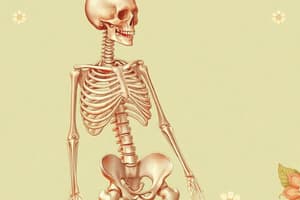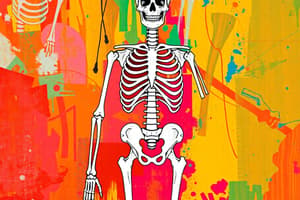Podcast
Questions and Answers
What is one of the primary functions of bones in the musculoskeletal system?
What is one of the primary functions of bones in the musculoskeletal system?
- Storing information
- Conducting electrical signals
- Haemopoiesis (correct)
- Producing hormones
Which type of bone is primarily responsible for providing the framework of the body?
Which type of bone is primarily responsible for providing the framework of the body?
- Long bones (correct)
- Short bones
- Irregular bones
- Flat bones
What distinguishes long bones from short and flat bones?
What distinguishes long bones from short and flat bones?
- Presence of a shaft and extremities (correct)
- Location in the skull
- Composition of spongy bone
- Type of growth plate present
Which layer is found covering long bones, providing protection and allowing tendon attachments?
Which layer is found covering long bones, providing protection and allowing tendon attachments?
What is the primary function of osteoblasts in bone tissue?
What is the primary function of osteoblasts in bone tissue?
What is the primary composition of the inorganic matrix in bone?
What is the primary composition of the inorganic matrix in bone?
Which type of bone is the patella classified as?
Which type of bone is the patella classified as?
Which statement best describes the function of osteocytes?
Which statement best describes the function of osteocytes?
What do osteoclasts primarily do in bone metabolism?
What do osteoclasts primarily do in bone metabolism?
What is the role of the metaphysis in long bones?
What is the role of the metaphysis in long bones?
What kind of bone structure does the epiphysis of long bones primarily contain?
What kind of bone structure does the epiphysis of long bones primarily contain?
Which component accounts for the majority of bone mass in the body?
Which component accounts for the majority of bone mass in the body?
What structure forms the central part of the vertebral column?
What structure forms the central part of the vertebral column?
Which of the following describes the layout of compact bone?
Which of the following describes the layout of compact bone?
What is the primary role of lacunae in compact bone?
What is the primary role of lacunae in compact bone?
How are the cervical and lumbar vertebrae differentiated?
How are the cervical and lumbar vertebrae differentiated?
What forms the lateral walls of the vertebral arch?
What forms the lateral walls of the vertebral arch?
Which vertebra allows for the nodding of the head?
Which vertebra allows for the nodding of the head?
What is the composition of intervertebral discs?
What is the composition of intervertebral discs?
Which type of vertebrae are the largest?
Which type of vertebrae are the largest?
Where do spinal nerves exit the vertebral column?
Where do spinal nerves exit the vertebral column?
What connects the vertebrae and maintains the position of intervertebral discs?
What connects the vertebrae and maintains the position of intervertebral discs?
How many thoracic vertebrae are there?
How many thoracic vertebrae are there?
What is the purpose of the vertebral foramina?
What is the purpose of the vertebral foramina?
What is the primary function of the transverse ligament?
What is the primary function of the transverse ligament?
Which ligament is found inside the vertebral canal and runs the length of the vertebral bodies?
Which ligament is found inside the vertebral canal and runs the length of the vertebral bodies?
How many primary curves are present in the vertebral column when viewed from the side?
How many primary curves are present in the vertebral column when viewed from the side?
Which of the following movements is least limited in the cervical region of the vertebral column?
Which of the following movements is least limited in the cervical region of the vertebral column?
What is the classification of the first seven pairs of ribs?
What is the classification of the first seven pairs of ribs?
Which part of the sternum articulates with the clavicles?
Which part of the sternum articulates with the clavicles?
What structural feature does the vertebral column provide for spinal nerves and blood vessels?
What structural feature does the vertebral column provide for spinal nerves and blood vessels?
Which of the following ligaments connects the laminae of adjacent vertebrae?
Which of the following ligaments connects the laminae of adjacent vertebrae?
Flashcards
Long bones
Long bones
Bones longer than they are wide, typically found in limbs like the femur.
Diaphysis
Diaphysis
The shaft of a long bone, consisting mainly of compact bone.
Epiphyses
Epiphyses
The extremities (ends) of a long bone, containing spongy bone.
Periosteum
Periosteum
Signup and view all the flashcards
Bone Functions
Bone Functions
Signup and view all the flashcards
Compact bone
Compact bone
Signup and view all the flashcards
Spongy bone
Spongy bone
Signup and view all the flashcards
Bone Constituents
Bone Constituents
Signup and view all the flashcards
Collagen's Role in Bone
Collagen's Role in Bone
Signup and view all the flashcards
Osteoblast Function
Osteoblast Function
Signup and view all the flashcards
Osteocytes: Bone Guardians
Osteocytes: Bone Guardians
Signup and view all the flashcards
Osteoclast's Role
Osteoclast's Role
Signup and view all the flashcards
Compact Bone's Structure
Compact Bone's Structure
Signup and view all the flashcards
What is an Osteon?
What is an Osteon?
Signup and view all the flashcards
Spongy Bone: Honeycomb Structure
Spongy Bone: Honeycomb Structure
Signup and view all the flashcards
Axial Skeleton: Body's Core
Axial Skeleton: Body's Core
Signup and view all the flashcards
Vertebral Arch
Vertebral Arch
Signup and view all the flashcards
Vertebral Foramen
Vertebral Foramen
Signup and view all the flashcards
Transverse Process
Transverse Process
Signup and view all the flashcards
Spinous Process
Spinous Process
Signup and view all the flashcards
Intervertebral Disc
Intervertebral Disc
Signup and view all the flashcards
Intervertebral Foramina
Intervertebral Foramina
Signup and view all the flashcards
Cervical Vertebrae
Cervical Vertebrae
Signup and view all the flashcards
Atlas (C1) & Axis (C2)
Atlas (C1) & Axis (C2)
Signup and view all the flashcards
Intervertebral Foramina: Spinal Nerve Access
Intervertebral Foramina: Spinal Nerve Access
Signup and view all the flashcards
Study Notes
Musculoskeletal System Overview
- The musculoskeletal system comprises bones, joints, and voluntary muscles
- This system provides the framework for the body, enables movement, and protects internal organs.
Bone Functions
- Provide the body framework
- Offer attachment points for muscles and tendons
- Enable body movement
- Protect internal organs
- Involved in hematopoiesis (blood cell production) within red bone marrow
- Store minerals, particularly calcium and phosphate
Types of Bones
- Bones are classified into long, short, irregular, flat, and sesamoid bones.
- Long bones: Longer than wide, found in limbs (e.g., femur)
- Short bones: Roughly cube-shaped, found in the wrist (e.g., carpals)
- Irregular bones: Varying shapes, found in the spine (e.g., vertebrae)
- Flat bones: Thin and flat, found in the skull (e.g., sternum)
- Sesamoid bones: Small, round bones embedded in tendons (e.g., patella)
Structure of a Long Bone
- A long bone consists of a shaft (diaphysis), two metaphyses (in children), and two extremities (epiphyses).
- The diaphysis is primarily compact bone with a central medullary cavity containing yellow bone marrow.
- The epiphyses consist of compact bone externally and spongy bone internally.
- The metaphysis contains the growth plate, responsible for bone lengthening in childhood.
Bone Covering and Cartilage
- Long bones are covered by the periosteum, a tough outer layer for protection and tendon attachment.
- Hyaline cartilage is present on joint surfaces, reducing friction during movement.
Bone Tissue Composition
- Bone is a strong and durable connective tissue.
- It's composed of inorganic matrix (mainly calcium phosphate) providing hardness, and organic material (primarily collagen) for flexibility.
Bone Cells
- Three key bone cells include:
- Osteoblasts: Bone-forming cells, depositing new bone and inorganic salts
- Osteocytes: Mature bone cells, monitoring and maintaining bone tissue
- Osteoclasts: Bone-resorbing cells, breaking down bone tissue, releasing calcium and phosphate
Compact Bone
- Makes up ~80% of the skeleton
- Organized into structural units called osteons (Haversian systems)
- Osteons consist of concentric rings of bone tissue (lamellae) surrounding a central canal (Haversian canal) containing blood vessels and nerves
- Lacunae contain osteocytes connected by canaliculi for nutrient transport
Spongy Bone
- Porous structure resembling a honeycomb
- Contains red bone marrow, crucial for blood cell formation
- Lighter than compact bone, offering support without excessive weight
- Composed of trabeculae, thin plates of bone tissue
Skeleton Classifications
- Axial skeleton: Skull, vertebral column, ribs, and sternum; forms the central axis of the body
- Appendicular skeleton: Limbs, shoulder girdle, and pelvic girdle
Vertebral Column
- 26 bones (24 movable + sacrum + coccyx)
- Divided into cervical, thoracic, lumbar, sacrum, and coccyx regions
- Each vertebra has a body, vertebral arch, and processes (transverse, spinous).
- Intervertebral discs act as shock absorbers between vertebrae.
- The vertebral column exhibits specific curves for posture and shock absorption
- Ligaments and joints maintain the vertebral column structure
- Specific cervical vertebrae (C1-atlas, C2-axis) allow specific movements
Thoracic Cage
- Composed of the sternum, ribs, and thoracic vertebrae
- Sternum: Flat bone in the anterior chest
- Ribs: 12 pairs; true ribs articulate directly with the sternum (1-7), false ribs indirectly articulate with the sternum (8-10), floating ribs are unattached medially
- Intercostal muscles facilitate rib cage movement during respiration (breathing)
Studying That Suits You
Use AI to generate personalized quizzes and flashcards to suit your learning preferences.




